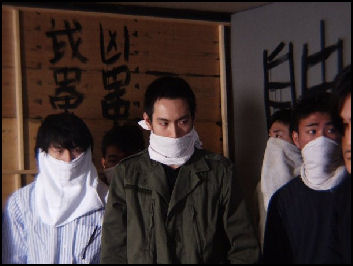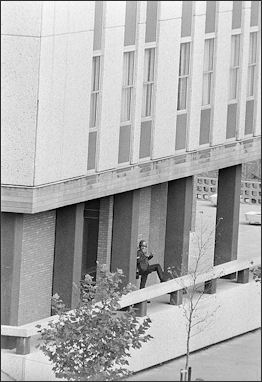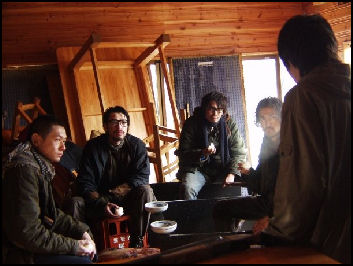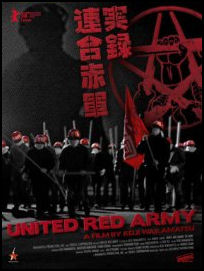JAPANESE RED ARMY

scene from the film United Red Army In the 1970s, the Japanese Red Army (JRA) was one of the world's most notorious terrorist groups. Initially a splinter group of the extreme left-wing United Red Army, the group was founded by Fusako Shigenobu in 1969 and was made up of radicals from student groups who protested the presence of U.S. military based in Japan. The goal of the group was to overthrow the Japanese government, eliminate the monarchy and foment world revolution.
In the early 1970s, the Red Army broke into factions. Shigenobu moved her faction to war-torn Lebanon and set up a commune, which allied itself with the Popular Front for the Liberation of Palestine and for fun held nightly self-criticism sessions. Pursued by Israeli agents they were constantly on the run. Even so Shigenobu had a daughter, with a Palestinian terrorist, who she raised with the help of other Red Army members and Arab supporters.
RECOMMENDED BOOKS: “Blood and Rage: The Story of the Japanese Red Army (1990) by William R. Farrell Amazon.com “Ashes to Awesome- Japan's 6,000-Day Economic Miracle” by Hiroshi Yoshikawa and Fred Uleman (2021) Amazon.com; “Inventing Japan: 1853-1964" by Ian Buruma (Modern Library, 2003) Amazon.com; “The Making of Modern Japan” by Marius B. Jansen Amazon.com; “The Cambridge History of Japan, Vol. 6: The Twentieth Century” by Peter Duus Amazon.com; “Hirohito and the Making of Modern Japan” by Herbert P Bix Amazon.com; “Embracing Defeat: Japan in the Wake of World War II” by John Dowser of Massachusetts Institute of Technology, who won the Pulitzer Prize for nonfiction in 1999. Amazon.com; “Japan Rearmed: The Politics of Military Power” by Sheila A. Smith (2019) Amazon.com; “Japan in Transformation, 1945–2020 by Jeff Kingston Amazon.com
Japanese Red Army Activities and North Korea
In 1970, nine Japanese Red Army member hijacked a Japan Airlines domestic flight, with 138 people on board, to North Korea. During this hijacking the plane landed at Seoul, where a North Korean flag was raised in attempt to trick the hijackers into thinking the plane had landed in Pyongyang. The trick didn't work. The hijackers became suspicious after U.S. airliners were spotted at the airport. The 129 passengers and cabin crew on board were released in Seoul. The plane continued on to Pyongyang, where the nine defected.
The Yodo-go incident was the first hijacking in Japan. One of the Red Army Faction members, Yasuhiro Shibata, was only 16. The plane was on a domestic flight from Tokyo to Fukuoka on March 31, 1970. Yodo-go was the name of the airplane.
The hijackers were granted political asylum. They were welcomed by Kim Il Sung as heroes and initially were feted to privileges like housing in a special revolution village and chauffeured Mercedes-Benz cars.. The hijackers married Japanese women secretly brought into the country. Over time their privileges were taken away and they lived under strict rules imposed by North Korea. Many become idle and bored.
Four of the Yodo hijackers remain in North Korea and will probably stay there. The Japanese government wants to talk to them because they could help answer some unanswered question about the abduction of Japanese citizens by North Korea. Of the 20 children born to Yodo hijackers all are living in Japan. All the hijacker wives live in Japan with the exception of two that remain in North Korea.
Japanese Red Army Activities in Japan
The Red Army executed 14 people in Japan between August 1971 and February 1972 and had shootouts with Japanese police. There were also believed to have had a hand in a 1974 bombing of Mitsubishi Heavy Industries in the central Tokyo business district that killed eight people and injured nearly 400 (this was last major terrorist incident in Japan before the Aum Shinrokyo poison gas subway attack in 1995).
Hiroko Nagata was a United Red Army member who was involved in the mass murder of her comrades in the early 1970s. According to court findings, Nagata conspired with other members of the radical group in the August 1971 murders of two members who tried to leave. She was also involved in the mass killing of 12 more members in a mountainous area of Gunma prefecture between December 1971 and February 1972 over ideological differences.
The Asama Sanso incident was the name given to 10-day stand-off in March 1972 between five Red Army members and police at the Asama Sanso mountain resort in Karuizawamachi, Nagano Prefecture. After Nagata’s arrest in February 1972, five members of the group, including Hiroshi Sakaguchi, 64, barricaded themselves into the Asama Lodge in Karuizawa, Nagano Prefecture, taking the wife of the lodge manager hostage. The ensuing gun battles with police, in which three officers were killed, were played out in front of television cameras over the following 10 days.
The incident began when the Red Army members quietly entered the lodge and took the wife of the lodgekeeper hostage. Police tracked the terrorists to the lodge following their footprints in the snow. A shoot-out took place when the terrorists were cornered by police. During the standoff 1,000 police took up positions around the lodge and sprayed the lodge with water cannons to to keep the terrorists from firing. The incident ended when the police stormed the lodge and rescued the hostage after smashing the walls with a wrecking ball. Two police and one member of the public died. .
To help obtain funds, the Red Army staged a series of attacks on post offices and financial institutions.
Japanese Red Army Activities in Europe and the Middle East

Japanese terrorists hold
the French embassy
in The Hague hostageOn May 30, 1972, three members of the JRA grabbed two suitcases from a conveyor belt in the passenger lounge of the Tel Aviv airport, pulled out submachine guns and grenades and opened fire into a crowd, killing 24 civilians, including 16 Puerto Ricans on a religious pilgrimage, and wounded 76. All of the terrorist were killed except for one, Kozo Okamoto, who was captured and imprisoned by Israeli authorities (See Below).
The Red Army was also involved in seizures at the French embassy in the Hague in 1974 and the Swedish and U.S. embassies in Kuala Lumpur in 1975 as part of efforts to win the release of jailed members.
The Red Army is believed to have worked with other international revolutionary groups such as the Red Brigade in Italy and the Baade-Meinhof Gang in Germany. In April 1988, the Red Army detonated a bomb in Naples as part of an anti-American campaign but was pretty quiet after that. Since the end of the Cold War the group has had difficulty securing funds.
Japanese Red Army Activities in Asia
The greatest hijacking ransom ($6 million) was paid by the Japanese government to the hijackers of a JAL flight with 38 hostages at Dacca Airport in Bangladesh in October 1977. The Red Army hijacked Paris-bound Japan Airlines over India. The government gave into the demands of the hijackers to win the release of the 156 passengers and get back the plane. The Prime Minister said, “Human life is weightier than the earth.” Six Red Army members were released. In 1973, JAL flight was redirected to Libya and the plane was blown up after the passengers were freed.
In the Dhaka incident in September 1977, then Prime Minister Takeo Fukuda took the extralegal measures of paying ransom and releasing Shirosaki and others for the lives of those aboard the JAL plane. The decision was criticized as Japan making concessions to terrorism.
The Red Army carried out mortar attacks on the Japanese and U.S. embassies in Jakarta in May 1986.
Japanese Red Army Hostage Crisis in Malaysia in 1975
In August 1975, five Japanese Red Army members took about 50 people hostage at the AIA the AIA (American Insurance Associates) Building in Jalan Ampang, Kuala Lumpur. The building housed U.S. consul and Swedish charge The hostages included the United States consul and the Swedish chargé d'affaires. The gunmen won the release of five imprisoned comrades and flew with them to Libya. [Source: Wikipedia, Kyodo]

scene from the film
United Red Army
by Koji Wakamatsu The Japanese Red Army was a militant organisation dedicated to eliminating the Japanese government and monarchy and launching a worldwide revolution. The organisation carried out many attacks and assassinations in the 1970s. The Japanese Red Army members entered the building and captured 53 people and held them hostage for 79 hours.They said they would kill the hostages if Tokyo did not agree to release seven JRA members who were in Japanese prisons.
The Japanese government agreed to the demands, although only five of the prisoners took up the offer of freedom. The prisoners were flown to Kuala Lumpur on a Japan Airlines aircraft, together with a crew of nine. Once the plane landed in Kuala Lumpur, the remaining hostages were handed over. The aircraft then left for Tripoli with the hijackers and former prisoners. Also on board were two Japanese government officials and two Malaysian officials who were there to ensure a safe passage. The JAL crew and government officials were released upon arrival in Libya. As a result of negotiations, JRA successfully obtained the release of five of their leaders imprisoned in Japan and Sweden. They were then flew by a DC-8 aircraft on August 7, 1975 to Libya.
In December 2005, Kyodo reported: “British government files show Malaysian officials were critical of Tokyo's slow response and Japan was frustrated by the lack of assistance from the United States, whose consulate in Kuala Lumpur was targeted by the terrorists. The documents also reveal that the chief Malaysian negotiator was confident he could have eliminated or captured all of the hostage takers at one stage in the ordeal, but feared that doing so would stimulate repeat attacks all over the world. [Source: Kyodo, December 29, 2005]
James Craig, Britain's deputy high commissioner in Kuala Lumpur, recounted a long conversation he had had with the U.S. charge d'affaires at the time following the incident. The American diplomat told him that the chief negotiator during the crisis, Malaysian Interior Minister Tan Sri Ghazali, was "no doubt at times...genuinely irritated by the Japanese." Malaysia was particularly concerned about the time it was taking to persuade JAL to supply an aircraft to transport the prisoners from Japan and then on to Libya.
Craig, summarizing the U.S. diplomat's views for his bosses in London, wrote, "The Japanese minister of transport who came here for the negotiations was disagreeable and the Japanese ambassador was clumsy: he seemed at one stage to reveal that the need to persuade JAL was only a ploy. "During the final negotiations at the airport the Malaysians seemed to suspect that the Japanese were trying some tricks without taking the Malaysians into their confidence -- for example, they wondered whether the insistence on a double (JAL) crew meant that the extra men came from some special unit."
In another conversation, Ghazali told Craig he could have killed or captured all the hijackers during the handover of the remaining hostages at the airport when two hijackers were inside the aircraft and three were outside on the tarmac. At the time, there were 10 Malaysian commandos at the scene. Craig wrote, "He (Ghazali) had only to press the button and the three terrorists on the ground would have been shot by snipers and the 10 policemen would have stormed the aircraft. "Perhaps one or two hostages might have been killed but the terrorists themselves would all have been shot or captured. But he (Ghazali) could not do it: he was haunted by the thought that if he did, Malaysian ambassadors and their families in all parts of the world would have been the victims of Japanese Red Army reprisals." Craig also revealed that another Malaysian official told him that two of the Japanese terrorists had carried grenades en route to Libya, despite assurances that they had gotten rid of all their explosives.
Following the crisis, it is understood that the Libyan authorities did not charge any of the JRA members, several of whom were involved in subsequent terrorist attacks. The terrorists included Haruo Wako, who was this year sentenced to life imprisonment in Tokyo for his role in the 1975 incident. Also involved was Junzo Okudaira who is still on the run. The Japanese Red Army was founded by Fusako Shigenobu in February 1971 and its height was one of the most feared terrorist groups in the world. It has close ties to the Popular Front for Liberation of Palestine.
Arrest of Japanese Red Army Terrorists

scene from the film
United Red Army
by Koji Wakamatsu Even though the Red Army had all but disappeared as a terrorist group Japanese law enforcement officials continued to hunt down the members that remained at large. In the early 1990s, three were apprehended in Romania, Peru and Nepal and another member was arrested in Bolivia.
Yoshima Tanaka, the man who hijacked the Japan Airlines flight in 1970, was arrested at the border of Vietnam and Cambodia in 1996 while traveling with a North Korean passport and was arrested for carrying large amounts of counterfeit $100 bills. He was deported to Thailand and then Japan. Another member died in Pyongyang and another was arrested in in 1988 after secretly trying to enter to Japan, where he was given a five-year prison sentence.
Red Army members Masai Adachi, Haruo Wako, Kazuo Tohira and Mariko Yamamoto were sent to Japan from Lebanon via Jordan in May 2000 as part of deal worked out between the Japanese, Jordanian and Lebanese governments. A fifth member Kozo Okamoto, who was involved in the Tel Aviv airport massacre, was given asylum in Lebanon as a reward for his anti-Israeli activities. He spent 13 years in Israeli prisons, where he was reportedly tortured. He was released in 1985 as part of a prisoner exchange deal.
The Japanese Red Army leader Fusako Shigenobu was arrested in Osaka in November 2000. She was found with several fake passports that indicated she had been traveling regularly between Japan, China and the Middle East. Shigenobu was charged with terrorist crimes associated with the seizure of the French Embassy in the Hague and the use of false passports. She pleaded innocent to the charges of terrorism and said she was not involved in the embassy seizure. Many believe Shigenobu was the mastermind of the Tel Aviv attack.
In February 2006, Shigenobu was given a 20 year prison sentence for her role in the seizure of the French Embassy in the Hague in 1974 and other incidents. Her daughter now lives in Osaka and visits her mother in prison regularly.
The death sentence on Sakaguchi was finalized in 1993, while Tsuneo Mori, who led the group, committed suicide at the Tokyo Detention House in 1973 at the age of 28.
A few Red Army members are still at large and believed to be living in North Korea or somewhere in the Middle East.
Deaths of Elderly Red Army Members
Hiroko Nagata was arrested in February 1972, and was sentenced to death by the Tokyo District and High courts. The lower court sentences were upheld by the Supreme Court in 1993. In February 2011, Nagata died at the Tokyo Detention House, still on death row, at the age of 65 following a long battle with brain cancer Nagata underwent surgery on a brain tumor in 1984. In 2006, she collapsed at the detention facility, suffering from brain atrophy and impaired consciousness, and was transferred to a medical prison in Tokyo’s Hachioji Ward.
In June 2011, Kyodo reported, Yasuhiro Shibata, the youngest Red Army Faction member involved in the so-called Yodo-go incident involving the hijacking of a plane to North Korea in 1970, was found dead at an apartment house in Osaka. He was 58. After receiving notification from an acquaintance who called at the apartment house on Thursday, police rushed to the scene and confirmed Shibata was dead in his room, the sources said, adding there was no sign of foul play. [Source: Kyodo, June 25, 2010]
Shibata had returned home in secret and was arrested by Hyogo prefectural police on charges of violating the passport law in May 1988. He was subsequently given a five-year prison term for burglary and other crimes, finalized in 1993, but was released the following year. Shibata and a Japanese woman had two daughters in North Korea and the three women also returned to Japan. The woman had admitted her involvement in the abduction of Japanese Keiko Arimoto, then 23, to North Korea. Shibata had been in poor health in recent years and was alienated from other Red Army Faction members remaining in North Korea, the sources said.
Red Army member Osamu Maruoka was involved in a series of hijackings. He conspired with Palestinian guerrillas in hijacking a Japan Airlines plane over Amsterdam in 1973. He also hijacked a JAL jumbo jet over India with four accomplices and forced it to land at Dhaka airport in Bangladesh in 1977. He was arrested in Tokyo in 1987 when he entered the country on a forged passport, put on trial and given a life sentence, which was finalized by the Supreme Court in 2000. Maruoka, died at a prison hospital in May 2011 at the age of 60.
Red Army Member Shirosaki Arrested in 2015
In February 2015, Tokyo police arrested Japanese Red Army member Tsutomu Shirosaki at Narita Airport over mortar attacks on the Japanese and U.S. embassies in Jakarta in May 1986. Sixty-seven-year-old Shirosaki was arrested on his arrival at the airport after his deportation from the United States, where he had served a jail term for his role in the U.S. Embassy attack. [Source: Jiji Press, February 21, 2015]
Jiji Press reported: “According to the Japanese arrest warrant, Shirosaki is suspected of attempted murder and arson in connection with the Japanese Embassy attack in the Indonesian capital. Shirosaki was among the six prisoners freed in 1977 to meet the demands of Japanese Red Army hijackers who forced a Japan Airlines plane to land in the Bangladeshi capital of Dhaka. The Public Security Bureau has set up a special investigative unit to shed full light on his whereabouts and activities between his release in 1977 and arrest in Nepal in 1996, before his deportation to the United States.
“Shirosaki may have contacted seven Japanese Red Army members still on the run and members of the communist militant group’s predecessor body who fled to North Korea by hijacking JAL’s Yodo aircraft in 1970. The arrest warrant said Shirosaki tried to kill people by firing explosives toward the Japanese Embassy around 11:30 a.m. on May 14, 1986, and to set fire to a hotel room to destroy evidence. The Public Security Bureau put him on the international wanted list on suspicion of attempted arson. Following additional investigations, the bureau became confident it could establish an attempted murder case against him.
“Shirosaki was born in Toyama Prefecture, and joined the predecessor organization after dropping out of the University of Tokushima, according to bureau sources. He was arrested in Tokyo in March 1971 and received a 10-year prison sentence for helping the Red Army erany money in a series of attacks on post offices and financial institutions. Until his arrest in Nepal in 1996 and subsequent deportation to the United States, he is believed to have stayed in various places including Thailand, Nepal, Bangladesh and Sri Lanka. In 1998, he was sentenced to 30 years in prison in the United States. He was released from jail in January this year after his term was reduced for good behavior. He was placed under strict supervision by U.S. authorities until his deportation to Japan.”
Image Sources: Wikimedia Commons, Kantei, office of Japanese Prime Minister; the film United Red Army by Koji Wakamatsu; Japan 101
Text Sources: New York Times, Washington Post, Los Angeles Times, Daily Yomiuri, Times of London, Japan National Tourist Organization (JNTO), National Geographic, The New Yorker, Time, Newsweek, Reuters, AP, Lonely Planet Guides, Compton’s Encyclopedia and various books and other publications.
Last updated September 2016

